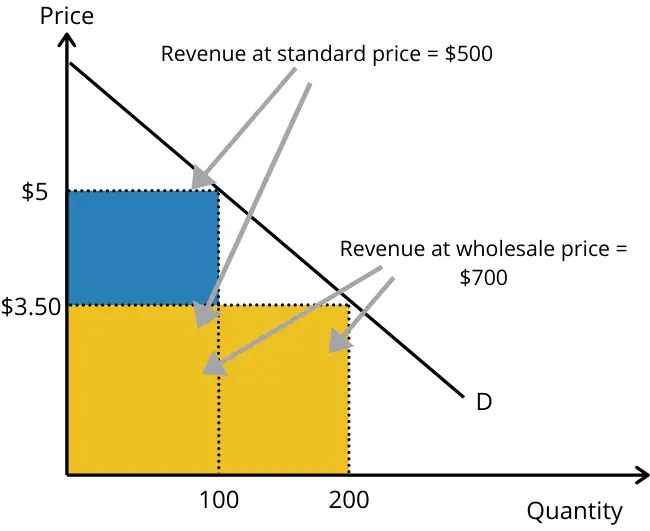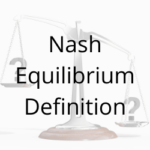Table of Contents ![]()
Second Degree Price Discrimination: Examples & Graph

What is Second Degree Price Discrimination
Second degree price discrimination is where a firm sells a good or service at different prices, based on quantity. For example, this may include offers such as buy two, get one free, or 20 percent off when you buy six.
It is a common pricing strategy used by warehouse retailers who are able to use economies of scale to make bulk purchases, and then pass these savings onto the consumer. Examples include the likes of Costco and Sam’s club who charge a small membership fee of around $50 – $60. This provides an incentive for members to buy bulk goods in order to justify the membership fee. However, because such retailers already buy the goods in bulk, they already benefit from lower costs which are then passed onto the consumer.
Key Points
- Second degree price discrimination occurs when consumers receive a discount on multiple purchases.
- Firms are able to offer lower prices for bulk purchases as they benefit from economies of scale.
- Examples of second-degree price discrimination include: coupons, buy two get one free, multi-packs, and loyalty cards.
Unlike other forms of price discrimination, second-degree price discrimination requires little effort to segment customers. For instance, first-degree price discrimination requires the firm to calculate each consumer’s maximum willingness to pay. By comparison, third-degree price discrimination requires the firm to segment into groups such as age or income group. Yet second-degree price discrimination only requires the firm to segment into those who want to buy in bulk and those who do not.
It is perhaps the most effective of all the types of discrimination due to the ease by which groups can be segmented. At the same time, bulk discounts encourage consumers to spend more. For example, offers such as buy two get one free encourage consumers to purchase another so they can get a further one for free. Even though consumers may not necessarily want another, it makes the second and third seem that much cheaper.
Firms can conduct this type of price discrimination due to economies of scale. The profit margins for one unit sold are usually quite high, which means they can reduce these margins for the subsequent units in order to encourage further consumption. So although the profit margin for the second unit may not be as high as the first, the overall profit is higher than it would be had only one been sold.
Second-Degree Price Discrimination Graph
Second-degree price discrimination can be a useful pricing strategy for a number of companies. It is mainly used by companies that have high-profit margins on the first unit sold – so can therefore reduce the price for subsequent units in order to incentivize further consumption.
The graph below demonstrates the sale of ice cream tubs. The usual retail price for these is $5 per tub. At this price, there is demand for 100 of these – thereby bringing in a revenue of $500. However, once a bulk discount is applied and the price is reduced to $3.50 – demand increase to 200, which brings revenue to $700.

The firm also has to produce an extra 100 units, but due to economies of scale, it is able to produce these at a lower cost than the first. This is due to falling average costs which occur due to the bulk orders that warehouse retailers are able to trade with. Therefore, the total profits the firm makes can be higher than comparative retailers.
Second Degree Price Discrimination Examples

Coupons
Many customers get coupons in the post or at the store as a way to encourage existing customers to come back and buy more. By offering a discount to those customers, the firm is able to attract repeat custom and increase sales. These are commonly adopted by retailers – usually in conjunction with a loyalty card. By offering coupons, customers are encouraged to come back and buy more goods from the store – albeit at a lower price.
Loyalty Cards
Loyalty cards are used by most supermarket retailers as well as restaurants and cafes. For example, some cafes offer a ticket whereby the customer receives a stamp with every visit. After 6 visits, the customer then receives a free coffee as thanks for their custom.
There are also loyalty cards at supermarkets which generally track the customer’s buying habits. They can then use that data to send through personalized promotional material to offer discounted goods. So consumers essentially sell their data to supermarkets in return for discounted prices to encourage them to come back and buy more goods.
Three for two
Three for two is a common offer that retailers use to increase sales by making subsequent purchases more appealing. Most customers only want the one good, but the thought of such a big discount on the next can attract many to spend more. This works in tandem with diminishing marginal utility whereby the customer starts to value each additional good less and less. The retailer’s solution is to offer a big discount on the subsequent purchase.
Bulk-buy
Bulk-buying is a classic form of second-degree price discrimination which offers a lower price per unit for customers that buy larger packs. For example, a can of Coca-Cola may cost $1, whilst a pack of 12 costs $6. That’s a discount of roughly 50 percent on the per-unit price as the multipack costs 50 cents each. Other examples include large tubs of ice cream, 24 packs of toilet papers, 6 pack of canned beans, and a 6 pack of doughnuts. All of which cost less per unit than individually.
Advantages of Second Degree Price Discrimination
Second degree price discrimination is a type of pricing strategy where firms charge different prices based on the quantity consumers buy. This strategy has a number of advantages to both the business but also consumers. Some advantages include:
1. Increase Revenue
By employing second degree price discrimination, firms have the potential to increase revenue. This is because they are able to capture a wider range of customers. Not only can they capture those who are happy to pay a higher price for a single unit, but also those who are more price sensitive. This allows the firm to capture more consumer surplus by catering for different types of consumers, with different levels of willingness to pay.
2. Utilise Production Capacity
By encouraging consumers to buy more, firms are able to fully-utilise existing capacity and reduce its costs per unit. For example, if a factory only has demand for 5 hours a day, it is missing out of many more hours of potential output. The fixed cost of paying for the factories up-keep and rent can therefore be spread out if it’s open the whole day. Therefore, by offering lower prices to consumers who buy more, it can increase the demand, thereby allowing the firm to fully utilise its resources.
3. Cater to Consumer Preferences
Being able to cater to various consumer preferences is another advantage of second degree price discrimination. By offering a range of products or bundles, companies can increase sales, but also cater to different customers. For example, gaming companies may offer console bundles with some of the popular games, but at a discounted rate than if purchased separately.
4. Promotes Competition
Finally, second-degree price discrimination can also promote a greater level of competition. By offering different pricing options, it can help firms stick out from competition and therefore capture a greater part of the market. In turn, other firms may look to change strategy by reducing prices and taking a more aggressive competitive approach.
Disadvantages of Second Degree Price Discrimination
There are many advantages to second-degree price discrimination. However, there are also many disadvantages which include:
1. Increased complexity
By offering multiple pricing options, it can make it difficult to keep track of the firms pricing strategies and to make any dynamic changes. For instance, if the firm is offering buy two, get one free – it may increase its prices, but that may then affect the profit margins they are making. This can lead to greater complexity when making strategic decisions, as well as higher administrative costs.
2. Customer confusion
When there are a number of pricing options, it can make it difficult for consumers to make a rational decision. This can affect customer experience as it can become difficult to work out which option is cheaper. For instance, is it cheaper to buy 3 of the smaller boxes or one large box, but the smaller boxes offer slightly more quantity. The emphasis is then on the consumer to do the math calculations to work out the best option.
3. Potential for cannibalization
By using second degree price discrimination, firms may experience a decrease in demand for the higher-priced options. As there are cheaper options available, it may push consumers who would have paid more, into the less profitable brackets. Therefore, overall profitability may be affected. Firms will need to consider this factor carefully and ensure the pricing strategy effectively segments the market.
4. Negative consumer perceptions
Some customers may perceive second-degree price discrimination as unfair or exploitative, leading to a negative impact on the business’s reputation and customer loyalty. Companies must carefully design and communicate their pricing strategies to minimize potential backlash.
5. Legal and regulatory issues
In some industries or jurisdictions, price discrimination may be subject to legal and regulatory scrutiny. Businesses need to ensure that their pricing practices comply with relevant laws and regulations to avoid potential penalties or damage to their reputation.
FAQs
Second degree price discrimination is where firms charge consumers a lower price for buying larger quantities.
Second degree price discrimination works as firms are able to pass on their benefits from economies of scale. At the same time, consumers utility diminishes for each additional unit they buy. For example, a consumer may value their first doughnut at $1.50, but they don’t really want more than just the one. Yet they would be willing to pay $0.75 for another as that value would represent the diminished utility they would receive from consuming another. So by offering additional units at a lower price, the seller is able to get around diminishing marginal utility.
Second degree price discrimination is not completely efficient as it doesn’t maximise the price the consumer is willing to pay – also known as the consumer surplus. So consumers are still paying less than they would potentially be willing to pay.
Examples of second-degree price discrimination can be found in various industries, such as:
– Airlines offering economy, premium economy, and business class tickets
– Software companies providing different versions of a product with varying features (e.g., basic, professional, or enterprise editions)
– Telecommunication companies offering phone plans with different data allowances, call minutes, and messaging limits
In most cases, second-degree price discrimination is legal, as it does not involve personalizing prices based on individual consumer characteristics. However, businesses should be aware of any industry-specific regulations or jurisdictional laws that may impact their pricing strategies.
About Paul
Paul Boyce is an economics editor with over 10 years experience in the industry. Currently working as a consultant within the financial services sector, Paul is the CEO and chief editor of BoyceWire. He has written publications for FEE, the Mises Institute, and many others.

Related Topics
Further Reading
 The Importance of Free Trade - True free markets don’t exist anywhere in the world. This is because free markets and free trade go hand in…
The Importance of Free Trade - True free markets don’t exist anywhere in the world. This is because free markets and free trade go hand in…  Current Ratio - The current ratio is a financial metric that measures a company's ability to meet its short-term liabilities with its short-term…
Current Ratio - The current ratio is a financial metric that measures a company's ability to meet its short-term liabilities with its short-term…  Nash Equilibrium: Definition, Limitations & Example - Nash equilibrium refers to the situation whereby a group of individuals choose the most optimal strategy and do not deviate…
Nash Equilibrium: Definition, Limitations & Example - Nash equilibrium refers to the situation whereby a group of individuals choose the most optimal strategy and do not deviate… 